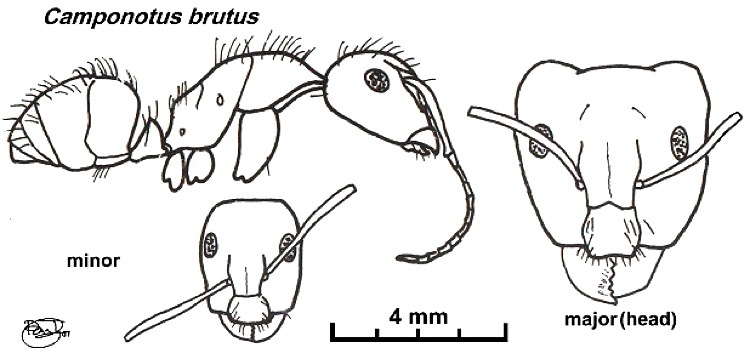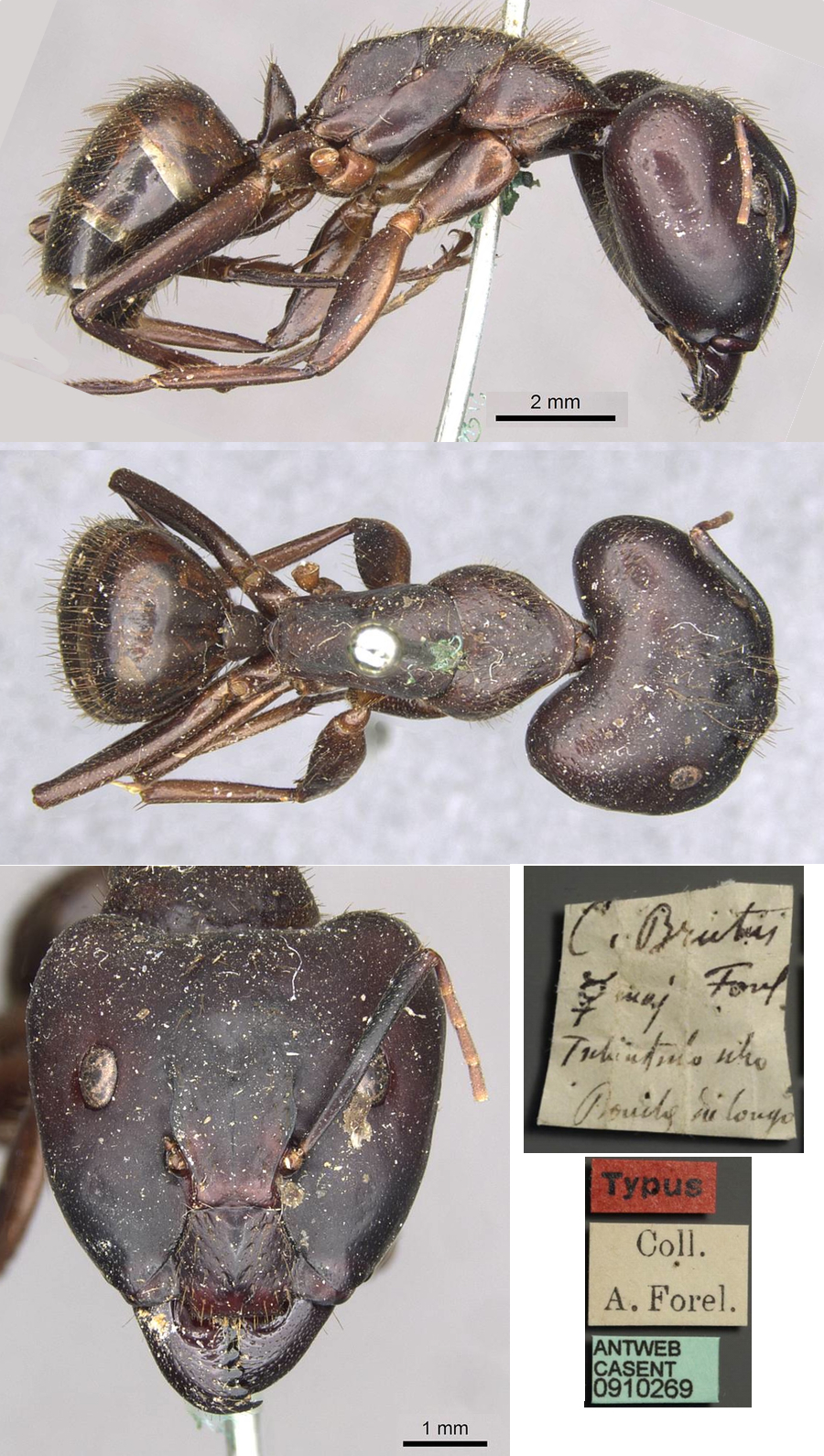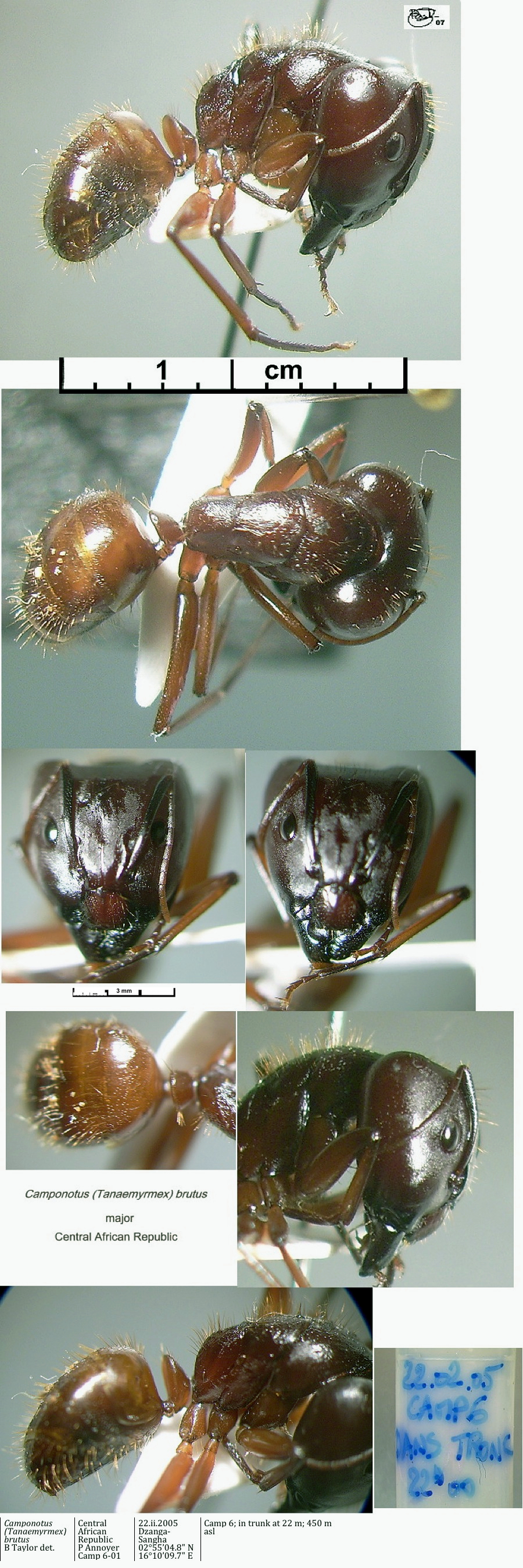Camponotus (Tanaemyrmex) brutus Forel
  Type location Angola
(Camponotus rubripes r. C. Brutus n. stirps, Forel,
1886f:
155, major & minor workers & queen; Mayr, 1895: 150, male) -
see below. Bolton (1995)
had this as "Raised to species: new
status", apparently from being a subspecies of Camponotus solon. Type location Angola
(Camponotus rubripes r. C. Brutus n. stirps, Forel,
1886f:
155, major & minor workers & queen; Mayr, 1895: 150, male) -
see below. Bolton (1995)
had this as "Raised to species: new
status", apparently from being a subspecies of Camponotus solon.
 . .
With a fresh and quite distinctive specimen from the
Central African Republic, I have elevated unavailable variety name Camponotus
(Tanaemyrmex) lycurgus (Emery, 1899e: 501, worker) from Cameroun
to full species status.
|
 Forel's (1886f) description is at Forel's (1886f) description is at  and and  , with comments by Emery (1899e) at , with comments by Emery (1899e) at  . Forel's specimens came from Chinchoxo,
near the mouths of the Congo, collected by Dr Falkenstein; plus a
soldier from Gabon, collected by M. Bütner. Mayr's (1895)
description of the male is at . Forel's specimens came from Chinchoxo,
near the mouths of the Congo, collected by Dr Falkenstein; plus a
soldier from Gabon, collected by M. Bütner. Mayr's (1895)
description of the male is at  . The specimens were from Senegal and
Cameroun. . The specimens were from Senegal and
Cameroun.
|
Wheeler (1922) had it as a subspecies of maculatus,
listing its denotation as a full species by Dalla Torre (1893: 134).
Among the known distribution were Sierra Leone (Samlia Falls,
by Mocquerys), Liberia, and Cameroun (Sjöstedt and H.
Brauns, at Victoria by F. Silvestri and H. Winkler, at Mundame by
Conradt, Nssanakang by Rudatis, Bibundi and Mokundange by Tessmann, and
Yukaduma by Schultze); elsewhere were findings in the Congo areas. He
noted it nests in rotten wood, and that it was found nesting in an old
oil palm trunk. Forel (1911f) reported brutus (as ssp of maculatus)
from Zaïre, Kasai, Kondué by Luja; and Lukula by Daniel .
|
 Nigeria specimens (Taylor, 1978: 5) Nigeria specimens (Taylor, 1978: 5)
MAJOR. TL 15.38 mm, HL 4.43, HW 4.75, SL 3.23, PW 2.72
MINOR. TL 11.00 mm, HL 3.04, HW 2.41, SL 3.23, PW 1.96
Colour dark red-brown, extremities orange, shiny. Erect hairs coarse
and relatively sparse. Declivity of propodeum obtusely angled. Petiole
a sharp scale.
In Nigeria it nests most commonly in large holes
in forest trees, with the hole entrance being covered over with matted
plant material; also in dead wood on living trees. Occasionally seen
foraging on cocoa; also on native trees.
Found in Ghana, on the ground and herbs under
cocoa at the Mampong Cemetery Farm, and sampled five times in the cocoa
canopy survey (Room, 1971); Majer found it in 18.8% of his 144 pkd
samples at Kade, with 20-40 workers per sample (1975, 1976a, b, c); and
on cocoa mistletoe (Room, 1975). Room (1971) found it to be positively
associated with Crematogaster depressa and Tetramorium
aculeatum.
In their study of the Campo
forest canopy, Dejean, Belin and McKey (1992; see also Dejean et al.,
2000a) found it on the canopy and midtrunk of 20 of 167 primary forest
trees; a sub-dominant tolerated by Crematogaster depressa and
nesting in hollow branches or under bark. They described it as
nocturnal and, if a normal dominant is absent, being capable of
developing polydomous colonies and so occupying the whole canopy of a
tree (8 trees). In the absence of dominant ants, C. brutus
tended Coccids (Ceroplastes species) and Diaspids (Aspidiotini
species, on one each of the trees studied.
|
Arnold's (1922) description is at  . .
|
 The photomontage of the type major worker
is collated from http://www.antweb.org/specimen.do?name=casent0910269. The photomontage of the type major worker
is collated from http://www.antweb.org/specimen.do?name=casent0910269.
|
 The photomontage of the type minor worker
is collated from http://www.antweb.org/specimen.do?name=casent0910270. The photomontage of the type minor worker
is collated from http://www.antweb.org/specimen.do?name=casent0910270.
|
Oxford University Museum
specimens
Camponotus (Tanaemyrmex) brutus
B Taylor det.
|
Cameroun
A Fotso Kuate
Camponotus sp2
|
27.vii.2007
Matomb
03°54'30" N
11°25'58" E
|
Quadrat in fallow
|
1
|
 |
Camponotus (Tanaemyrmex) brutus
B Taylor det. |
Gabon
Y Braet
Gabon 39
|
9.vi-27.vi.2006
Pongara
00°34' N
09°19' E
|
Pointe Wingombe;
forest edge; malaise trap |
1
|
 |
Camponotus (Tanaemyrmex) brutus
B Taylor det. |
Gabon
Y Braet
Gabon 123
|
22.vii.2006
Pongara
00°34' N
09°19' E
|
Pointe Denis,
savannah, sweep net
|
1
|
 |
Camponotus (Tanaemyrmex) brutus
B Taylor det. |
Central African
Republic
P Annoyer
Camp 6-01
|
22.ii.2005
Dzanga-Sangha
02°55’04.8" N
16°10’09.7" E
|
Camp 6; in trunk at
22 m; 450 m asl
|
5
|
 |
Camponotus (Tanaemyrmex) brutus
B Taylor det.
Queen
|
Central African
Republic
P Annoyer
Ei
|
01.ii.2005
Dzanga-Sangha
02°49'07.9" N
16°09'28.3" E
|
377 m; Camp 2;
20h-7h; Sur plate-forme à 35 m du sol dans un Azobé (Lophira alata, Ochnaceae)
|
1
|
 |
Camponotus (Tanaemyrmex) brutus
B Taylor det. |
Central African
Republic
P Annoyer
EM
|
03.ii.2005
Dzanga-Sangha
03°01'49.5" N
16°08'31.7" E
|
567 m 18h-6h30; Sur
banc de sable au milieu du fleuve Sangha, 400 mètres en amont du camp 2
|
1
|
|
Camponotus (Tanaemyrmex) brutus
B Taylor det. |
Central African
Republic
P Annoyer
HP
|
09.x.2008
Dzanga-Sangha
03°07'06.4" N
16°07'59.2" E
|
373 m; Camp de
transit 1; 18h30-3h; Bord fleuve Sangha
|
1
|
|
Camponotus (Tanaemyrmex) brutus
B Taylor det.
Queen
|
Central African
Republic
P Annoyer
GE
|
18.ii.2005
Dzanga-Sangha
02°53'25.9" N
16°10'26.4" E
|
409 m; Camp 5;
18h30-6h; Sur plate-forme à 40 m du sol dans un Kosipo (Entandrophragma candollei,
Meliaceae) |
1
|
 |
Camponotus (Tanaemyrmex) brutus
B Taylor det. |
Central African
Republic
P Annoyer
LB |
25.x.2008
Dzanga-Sangha
03°05'20.6" N
16°10'43.0" E
|
364 m; Camp transit
3; 18h-5h; bord fleuve sangha Au camp, à 5 m du bord du fleuve
Sangha
|
2
|
|
Camponotus (Tanaemyrmex) brutus
B Taylor det. |
Central African
Republic
P Annoyer
LV |
15.xi.2010
Dzanga-Sangha
2°27'11.6"N 16°04'58.7"E
|
343 m; nuit, à vue
derrière village, Molongo, fromager au sein de la strate arbustive
(Casside land)
|
1
|
 |
Camponotus (Tanaemyrmex) brutus
B Taylor det.
Queen
|
Central African
Republic
P Annoyer
MJ |
19.xi.2010
Dzanga-Sangha
2°28'45.9"N 16°13'15.0"E
|
396 m; nuit, à vue,
au camp de transit 2 (près lac 1)
|
1
|
 |
Camponotus (Tanaemyrmex) brutus
B Taylor det.
Queen
|
Central African
Republic
P Annoyer
MX1B |
22.xi.2010
Dzanga-Sangha
2°29'19.1"N 16°13'58.4"E
|
401 m; nuit, équipe
1, 4h-5h, sur grosse liane pourrissante, bord lac 3
|
1
|
 |
Camponotus (Tanaemyrmex) brutus
B Taylor det. |
Central African
Republic
P Annoyer
OC1 |
25.xi.2010
Dzanga-Sangha
2°28'49.5"N 16°12'55.9"E
|
392 m
"OC bis sol"
|
1
|
 |
Camponotus (Tanaemyrmex) brutus
B Taylor det. |
Central African
Republic
P Annoyer
PZ |
30.xi.2010
Dzanga-Sangha
2°28'49.5"N 16°12'55.9"E
|
392 m; nuit, à vue,
Sipo trap on tree at mid-trunk, camp de base lac 1, samuel
|
1
|
|
Camponotus (Tanaemyrmex) brutus
B Taylor det. |
Central African
Republic
P Annoyer
PCO2 |
25.xi.2010
Dzanga-Sangha
2°28'49.5"N 16°12'55.9"E
|
392 m; pitfall/dung
trap, Lake 1 base
|
1
|
|
Camponotus (Tanaemyrmex) brutus
B Taylor det. |
Central African
Republic
P Annoyer
PCO4
|
26.xi.2010
Dzanga-Sangha
2°28'49.5"N 16°12'55.9"E
|
392 m; pitfall/dung
trap, Lake 1 base
|
4
|
 |
Camponotus (Tanaemyrmex) brutus
B Taylor det. |
Central African
Republic
P Annoyer
PCO2
|
27.xi.2010
Dzanga-Sangha
2°28'49.5"N 16°12'55.9"E
|
392 m; pitfall/dung
trap, Lake 1 base
|
1
|
 |
Camponotus (Tanaemyrmex) brutus
B Taylor det. |
Central African
Republic
P Moretto
xii.2012
|
Sangha
PN Ndoki
02˚28'39" N
22˚01'20" E
|
07-08
Lac 1, forêt à Gilbertiodendron, piège malaise
minor
|
3
|
 |
|
 The
photomontage is of a major specimen from Gabon, Pongara
National Park, 0°19'336"N 0°19'102"E, 1-8.viii.2006, sweep net in
sesame and forest, collector Yves Braet. The
photomontage is of a major specimen from Gabon, Pongara
National Park, 0°19'336"N 0°19'102"E, 1-8.viii.2006, sweep net in
sesame and forest, collector Yves Braet.
|
 The
photomontage is of a major from the Central African Republic,
Dzanga-Sangha Nature Reserve, 02°55’04.8" N 16°10’09.7" E 450m; environ
Camp 6; 22.ii.05; in trunk at 22 m collector Philippe Annoyer. The
photomontage is of a major from the Central African Republic,
Dzanga-Sangha Nature Reserve, 02°55’04.8" N 16°10’09.7" E 450m; environ
Camp 6; 22.ii.05; in trunk at 22 m collector Philippe Annoyer.
|
 Photomontage
of a minor from Gabon; Pongara National Park, Pointe Wingombé,
0°19'336"N 0°19'102"E, 9-27.vi.2006, malaise trap at edge of savannah
forest, collector Yves Braet. Photomontage
of a minor from Gabon; Pongara National Park, Pointe Wingombé,
0°19'336"N 0°19'102"E, 9-27.vi.2006, malaise trap at edge of savannah
forest, collector Yves Braet.
|
 Photomontage
of a media worker from the Central African Republic,
Dzanga-Sangha
Nature Reserve, 02°55’04.8" N 16°10’09.7" E 450m; environ Camp 6;
22.ii.05; in trunk at 22 m collector Philippe Annoyer. Photomontage
of a media worker from the Central African Republic,
Dzanga-Sangha
Nature Reserve, 02°55’04.8" N 16°10’09.7" E 450m; environ Camp 6;
22.ii.05; in trunk at 22 m collector Philippe Annoyer.
|
 The
photomontage is of a minor from the Cameroun,
Matomb; 3°49' 0 N 11°4'0"E; highland area elevation >500m; Quadrat
in fallow; 27.vii.2007; coll. A Fotso Kuate. The
photomontage is of a minor from the Cameroun,
Matomb; 3°49' 0 N 11°4'0"E; highland area elevation >500m; Quadrat
in fallow; 27.vii.2007; coll. A Fotso Kuate.
.
|
 The
photomontage is of a queen from the Central African Republic,
Dzanga-Sangha Nature Reserve, 18.ii.2005 18h30-6h Camp 5 02°53'25.9" N
16°10'26.4" E 409 m Sur plate-forme à 40 m du sol dans un Kosipo (Entandrophragma
candollei, Meliaceae), collector Philippe Annoyer. The
photomontage is of a queen from the Central African Republic,
Dzanga-Sangha Nature Reserve, 18.ii.2005 18h30-6h Camp 5 02°53'25.9" N
16°10'26.4" E 409 m Sur plate-forme à 40 m du sol dans un Kosipo (Entandrophragma
candollei, Meliaceae), collector Philippe Annoyer.
|
|